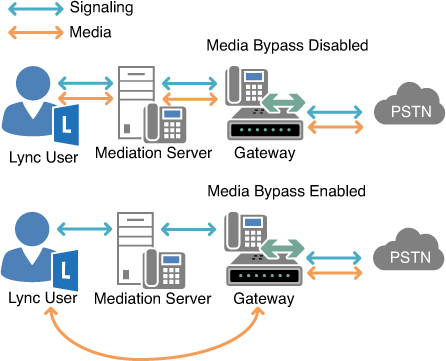The Mediation Server in Microsoft Lync Server
2013 is a service that connects your Lync users and Lync Servers to the
PSTN. This server role is required for any connections to the PSTN or a
legacy PBX infrastructure. When organizations are planning to deploy
Enterprise Voice or Dial-In Conferencing, a Mediation Server must be
deployed and connected to a next-hop PBX or PSTN. There are various
ways to connect to the PSTN, including a PSTN Gateway, an IP-PBX, as
Session Border Controller (SBC), or directly to a SIP trunk.
The Mediation Server is
a back-to-back user agent (B2BUA). A B2BUA operates between both
endpoints in a SIP call to facilitate communications. When routing
calls to the PSTN, users are directed to a Mediation Server. The
Mediation Server receives a PSTN call request directly from Lync
clients and divides the call into two signaling and media sessions. The
Mediation Server then initiates a call through the PSTN device it is
connected to. During PSTN calls, all SIP signaling routes through the
Mediation Server. Additionally, media can also route through the
Mediation Server if Media Bypass has been disabled. Figure 1
outlines a sample call flow between a Lync client and the PSTN with the
Mediation Server managing all signaling during the call.

Figure 1. Mediation Server signaling example.
All SIP signaling will traverse the Lync
Mediation Server, but media can travel directly from Lync users and the
PSTN gateway or IP-PBX. Lync Server 2010 introduced the Media Bypass
feature, which allows Lync users to send media directly to supported
gateways or PBXs using the G.711 media codec. This feature remains in
Lync Server 2013 and provides improved call quality, and much larger
capacity to the Mediation Server role. Figure 2 provides two examples of how media could flow in Lync Server 2013: with Media Bypass disabled and with it enabled.

Figure 2. Mediation Server media flow example.
Media Bypass becomes
more attractive in branch site scenarios. When a branch site is
connected to a centralized Lync infrastructure and that branch site has
its own PSTN connectivity, Media Bypass can allow Lync users in the
branch site to communicate directly with the local media gateway,
greatly reducing bandwidth requirements over the WAN.
The Mediation Server can also provide PSTN
connectivity to remote users through the Lync Edge Server. When remote
users make PSTN calls, they will be connected to a Mediation Server
through the Edge Server, and the signaling and media flow will be
handled as if the users were on the corporate network with the
exception of Media Bypass, which is not enabled in Edge Server
scenarios. As a summary, the Mediation Server is responsible for the
following functions in Lync Server 2013:
• Encrypting and decrypting media from Lync users to a legacy PBX or the PSTN
• Maintaining SIP signaling sessions over TCP and/or TLS between Lync users and the PBX or PSTN
• Translating and/or transcoding media streams between Lync users and servers and the PBX or PSTN
Mediation Server Collocation
By default, the Mediation Server role is
collocated with the Front End Server role. Microsoft supports
collocation of the Mediation Server role with the Front End Server
role, but no other server roles. Although it is supported, collocation
should be carefully planned for based on the following:
• The number of gateway peers the Mediation Server will be connected to
• The amount of traffic through those gateways
• The percentage of calls that are enabled for Media Bypass
The Mediation Server can require heavy
processing for media traversal and transcoding in some scenarios.
Often, small organizations can collocate the Mediation Server role;
however, many larger organizations will require dedicated Mediation
Server roles for capacity purposes. Media Bypass also has a major
impact on the number of calls a Mediation Server can support.
Table 1. Mediation Server Collocated Capacity Numbers
